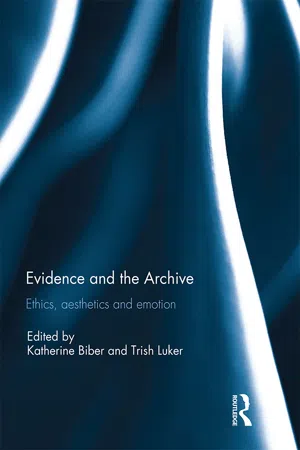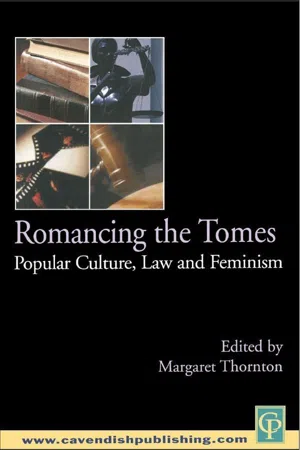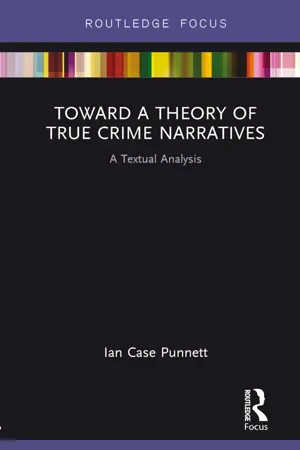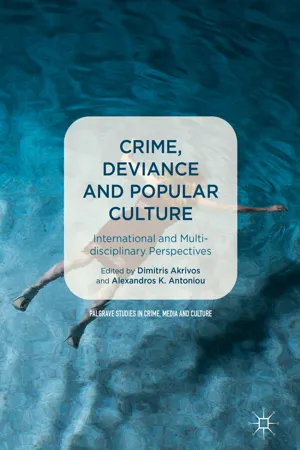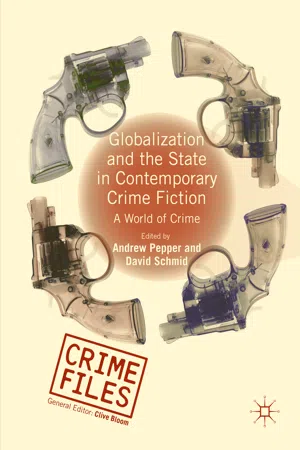Literature
True Crime
True crime literature is a genre that focuses on real-life criminal events, investigations, and legal proceedings. It often delves into the psychology of criminals and the impact of their actions on victims and society. True crime narratives are typically non-fictional accounts that aim to provide insight into the complexities of criminal behavior and the criminal justice system.
Written by Perlego with AI-assistance
Related key terms
Related key terms
1 of 4
Related key terms
1 of 3
7 Key excerpts on "True Crime"
- eBook - ePub
Evidence and the Archive
Ethics, Aesthetics and Emotion
- Katherine Biber, Trish Luker, Katherine Biber, Trish Luker(Authors)
- 2018(Publication Date)
- Routledge(Publisher)
2 As Katherine Biber notes:In other words, writing about in-court processes can be legally, ethically, and creatively fraught. True Crime is one of the very oldest in literature, and has, as Luc Sante points out, ‘spent much of its career in the literary slums’:During the criminal trial, strict rules govern the collection, admission and interpretation of evidence at trial. However, after the conclusion of the trial, this material returns to a notional archive and is sometimes used by [cultural users] but is subject to no rules or standards.3the nonfictional narrative of crime has chiefly been associated with such raffish vehicles as the ballad broadside, the penny-dreadful, the tabloid extra, the pulp detective magazine, and the current pestilence of paperbacks uniform in their one-sentence paragraphs, two-word titles, and covers with black backgrounds, white letters, and obligatory splash of blood.4Literary and mass-market writing about crime, criminals, and justice has a long history in Australia. There is a duality to True Crime writing, ‘an epistemological tension that haunts the genre’.5 It relies simultaneously on, firstly, the rhetoric of truth claims and, secondly, on myth and story as its narrative strategies. As Rosalind Smith notes:True Crimes can only be retrieved through unreliable memory or a range of textual sources such as photographs, interviews police reports, court transcripts, and newspaper accounts, and the resulting narratives declare their dependency upon the unstable textual interpretation at the same time as they claim to present the facts.6Many writers of True Crime are deeply aware of the duality about which Smith writes, and they explicitly weave meta-fictional concerns with ‘truth’ into their texts. For example, Evil Angels (1985) by John Bryson,7 Joe Cinque’s Consolation (2004) by Helen Garner,8 and The Tall Man (2008) by Chloe Hooper9 inevitably call into play and explicitly address ‘in the text’ complex issues of authority, epistemology, procedural and legal ethics.10 The ‘quest for truth’ within the narrative — the ‘mystery’, the processes of detection, uncovering, revealing, the investigative procedure, and the court proceedings — offer a perfect concrete enactment of those other epistemological questions that hover behind all writing. Thus, True Crime is one writing genre (memoir and biography are others) in which it could be said that these issues are addressed as equal status questions along with the primary narrative subject matter. A famous instance, for example, is Janet Malcolm’s The Journalist and the Murderer (1990),11 - eBook - ePub
Romancing the Tomes
Popular Culture, Law and Feminism
- Margaret Thornton(Author)
- 2013(Publication Date)
- Routledge-Cavendish(Publisher)
At one level we have the rather basic, though misleading distinction, between something called crime fiction and something that is labelled True Crime. I suggest that this distinction is misleading because True Crime covers a broad spectrum of story telling which ranges from the novelistic endeavours of Truman Capote’s In Cold Blood 10 or John Berendt’s Midnight in the Garden of Good and Evil 11 to the banal descriptions of murder and mayhem recounted by the notorious Australian former criminal, Chopper Read. And in each case we know that these accounts are storied representations of something that is supposed to have happened. What complicates this matter is that from Poe’s The Mystery of Marie Roget (first published in 1842) onwards, crime fiction has often been based on events that have taken place in the real world. While the distinction between the real and the fictional may be quite hard to sustain at a philosophical level, publishers and book shop owners all seem to agree on the need to distinguish between True Crime and crime fiction in order to market and sell them to readers who know what they prefer. It might be noted here that when I asked the male owner of one large London crime bookstore who bought True Crime, he informed me that it was mainly middle-aged ladies with rape fantasies; the female owner of an American crime book store told me it was largely dirty old men in raincoats, and the owner of an Australian store suggested it was consumed principally by nurses on night duty - eBook - ePub
Toward a Theory of True Crime Narratives
A Textual Analysis
- Ian Case Punnett(Author)
- 2018(Publication Date)
- Routledge(Publisher)
The textual analysis reaffirms that True Crime is written in a non-neutral literary voice that is rich in color and detail, with an emphasis on geography and ethnography as a frame for the crime, the victims, and/or the perpetrators. Almost all True Crime texts discussed above focused on justice for victims, although who is being defined as a victim may change, and it was common to see a text call for greater action to prevent crime or bring suspects to justice. Even in its earliest years, True Crime displayed a fascination with crime science of every type, embracing the publication of sometimes gruesome photography and physical evidence. An observable subversive tone is often present that is pro-justice, but may be outside the law, such as street justice or economic justice, or a tone that may not be pro-police or pro-status quo. Another common device of True Crime is the use of narratives conveying moral messages to different publics without becoming pedantic, echoing folktales.To determine the likelihood that an artifact of any media is located in the True Crime genre, a two-stage process of analysis mandates that it should first be determined whether the narrative about a crime is striving to be as true as possible (although for the pedagogical purposes of this interrogation, it is saved for last). To the extent that it is true that every story is somewhere on the continuum between fact and fiction, fundamental to the acceptance of a story as True Crime is its bipolar movement toward factuality. Because no story told by humans can ever be 100 percent correct, the maker of a True Crime text must be dependent on the untidiness of reality; if so, then the teleology of the story is moving toward truth. This first stage of a Theory of True Crime is cited as the teleology (TEL) code.The TEL code should be the sole, primary criterion for a text to be considered True Crime. If a text does not meet the conditions of the TEL code, then no further investigation of its other elements would be necessary. As history indicates, a definitive determination of the TEL may take years to assess with confidence. Some crime texts may present themselves as fact-based, but after investigation and analysis, reveal themselves as dominantly fictive at a later date. - eBook - ePub
- Gwyn Symonds(Author)
- 2011(Publication Date)
- Continuum(Publisher)
348 —where the gun mentioned in the first act must inevitably be discharged in a later act and there are no random events. The True Crime genre struggles with that Chekhovian dramatic imperative driven by its voyeuristic audience’s need for explanations and closure that is narrative reassurance that violence will be contained by society in the end.The acceptance of the fact that investigative journalism in the True Crime narrative is adulterated by fiction has in some instances been embraced as a selling point. The back cover blurb to Susan Mitchell’s All Things Bright and Beautiful: Murder in the City of Light promotes the genre of True Crime as a hybrid of fact and fiction: “Using a compelling blend of investigative journalism, interview, fact, and fiction, Susan Mitchell reveals Adelaide’s very different worlds, from wealthy and hedonistic, to the wretched and the deadly.”349 It is that blend that accounts for the allure of the genre, allowing fiction to fill in what investigation cannot, and avoiding what would be, from the audience’s point of view, narrative letdown instead of a compelling story. Recalling Truman Capote’s seminal designation of True Crime writing, embodied in his In Cold Blood —as nonfiction novelization—Susan Weiner, on the other hand, asks whether the contradictions inherent in such an approach, where reporting as an investigative journalist vies with the novelistic imagination, might not lead to fiction and fact being the same, or canceling each other out:Since by definition all events have occurred, the writer cannot possibly know what happened or what someone thought or said. Therefore, despite the extensive use of quoted conversations and cross-examinations, the reader has no idea of the source, accuracy, or completeness of those statements.350The implication of such a view is that journalistic True Crime should just be called fiction and be done with it. However, the True Crime historian Jonathan Goodman claims that it is precisely through the vantage point of recollection, or distance from the events of the crime, that the possibilities for narrative, if not actual truth, lie. Goodman argues that narrative truth is all that is possible in cases where events have occurred in a past beyond immediate recollection. Narrative is thus freed by time “to be thought of as a kind of fiction” with the writer “a novelist telling a truth.”351 As an author in the genre, Goodman clearly sees the facts of the case as essentially narrative fodder for a larger and “truer” story that can only be had by fictionalization. That such narrative truth may not be factual authenticity, or the truth assessed by those interviewed, or the truth of the trial verdict, for example, is clearly the implication of such a writerly, though somewhat vaguely defined, point of view.352 - eBook - ePub
Crime, Deviance and Popular Culture
International and Multidisciplinary Perspectives
- Dimitris Akrivos, Alexandros K. Antoniou, Dimitris Akrivos, Alexandros K. Antoniou, Dimitris Akrivos, Alexandros K. Antoniou(Authors)
- 2019(Publication Date)
- Palgrave Macmillan(Publisher)
The structure of conventional True Crime texts is in four parts: murder, biographies of the victims and killer, pursuit of the killer, and punishment of the killer. Some form of justice, usually the incarceration or execution of the perpetrator, is achieved by the end of the story. This structure mimics that of classical detective fiction; social order is re-established by the apprehension and punishment of a killer, reassuring the reader that justice does prevail and that our legal system works. Many writers who tackle murder narratives have some connection to a particular case: they are often journalists, investigators, law enforcement agents, or lawyers who have covered the crime for a media source or pursued and prosecuted the offender. True Crime books in this tradition include Capote’s In Cold Blood (1966), all the work of Ann Rule, and other books too numerous to list; television in this mode can be found on many shows produced by the ID Network (Investigation Discovery), and the long-running (1996–2011) television program ‘Forensic Files’ is a prime example of this form. Less common are the narratives penned by victims and survivors of extreme violence. These stories operate in an entirely different emotional register, as they give intimate details not just of murder, but of intense suffering and the extremely complex and challenging aftermath of violence. A distinct sub-group within the larger genre, True Crime memoirs suggest different ways of understanding and making sense of violence and trauma that do not rely on the conventional gothic formula that presents a simplistic view about innocence and evil - eBook - ePub
Women, Crime and Justice in Context
Contemporary Perspectives in Feminist Criminology from Australia and New Zealand
- Anita Gibbs, Fairleigh Gilmour, Anita Gibbs, Fairleigh Gilmour(Authors)
- 2022(Publication Date)
- Routledge(Publisher)
2017 , p. 69).Violence against women and girls
While the True Crime genre is diverse, VAWG is a subject that traverses the genre. TCPs focus disproportionately on the murder of girls and women who are usually (but not always) ideal victims in rare circumstances (Yardley et al. 2019 ). This continues a trend of partial representation of VAWG in the Australian context. For example, the murders of Anita Cobby in 1986 and Jill Meagher in 2012 both resulted in a plethora of True Crime representations to the exclusion of contemporaneous femicides involving less “ideal” victims (Serisier 2005, 2017 ).5 These texts also reproduce ideal victim tropes by infantilising female victims and conflating victimhood with sexual innocence (Serisier 2005 ) Additionally, the desire for “authenticity” has meant that True Crime texts rely on authenticating techniques such as autopsy images, crime scene photos (Browder 2006 ) and fetishising bodily representations (LaChance and Kaplan 2015 , p. 2) which dehumanise victims as sites of voyeuristic consumption. Moreover, True Crime authors have popularised responsibilising tropes by positioning their stories as cautionary tales for women (Browder 2006 , p. 942). This is illustrated in the popular American podcast My Favorite Murder , with its trademark sign off “Stay Sexy and Don’t Get Murdered” and merchandise flocked with sayings like “Lock Your Fucking Door” (Fitzpatrick 2017 ). However, the reproduction of tired victim-blaming tropes or flawed accounts of VAWG in TCPs is an open question. Yardley, Kelly and Robertson-Edwards (2019) argue that popular TCPs can subvert victim/offender tropes by critically examining wrongful convictions and the structural violence of the CJS. Moreover, some contemporary TCPs openly interrogate the role of victim-blaming in the investigation of and public response to femicide (Fitzpatrick 2017 - eBook - ePub
Globalization and the State in Contemporary Crime Fiction
A World of Crime
- Andrew Pepper, David Schmid, Andrew Pepper, David Schmid, Andrew Pepper, David Schmid(Authors)
- 2016(Publication Date)
- Palgrave Macmillan(Publisher)
True-crime is crime fact that reads like, or looks like, crime fiction…True-crime maps that vague and shifting region between real and fictional reality where mass belief resides. Thus, the known world of true-crime—the world as the scene of the crime—is bound up through and through with the reality of the mass media. (Seltzer, 11)Serious journalists and others who engage in true-crime investigation have traditionally derided the nota roja . It uses incendiary headlines and extraordinarily gruesome photographs, and puts little value on truth-seeking. Among crime tabloids Alarma! a.k.a. El Nuevo Alarma! and AlarmaRevista! has been particularly reviled as appealing only to the subliterate, as for instance, by Daniel Hallin:México tiene asimismo semanales sensacionalistas como ¡Alarma! , el cual ofrece un tipo de violencia obscena, como historias sobre atentados y, sobre todo, impactantes fotografías de cuerpos que han sido víctimas de accidentes o crímenes. La audiencia de estas publicaciones está constituida por varones de clase trabajadora, pese a que este grupo no es un fuerte consumidor de prensa escrita en México.[Mexico also has sensationalist weeklies like ¡Alarma! , which offers a kind of obscene violence, such as stories about assaults and, above all, shocking photographs of bodies that have been the victims of accidents or crimes. The readership of these publications is made up of men of the working class, in spite of the fact that this group is not a great consumer of the print news in Mexico]. (Hallin)On the other hand, serious journalists have not always acknowledged their own complicity in constructing the narrative of mayhem. Much of the reporting on “el narco” and “las muertas” is presented as an accumulation of empty linguistic commonplaces. Ignacio Corona terms this “an editorial politics of non-knowing,” in which “the news coverage spreads a discursive network over the ‘factual gap’ of the events” (106). Such reports parrot the official story with little investigative critique, and headlines syntactically imply agency and intention without specificity: “Matan a uno a golpes…Irrumpen en convivio y tirotean a pareja… Arrojan cadáver en la colonia Lino Vargas…Matan a menor de varias cuchilladas…Lo ejecutan en la colonia Del Carmen…A puñaladas matan adolescente…Siguen abusos,” and so on. The unnamed “ellos” of these constructions puts the focus on detailed descriptions of crime’s effects, rather than its agents.
Index pages curate the most relevant extracts from our library of academic textbooks. They’ve been created using an in-house natural language model (NLM), each adding context and meaning to key research topics.
Explore more topic indexes
Explore more topic indexes
1 of 6
Explore more topic indexes
1 of 4
